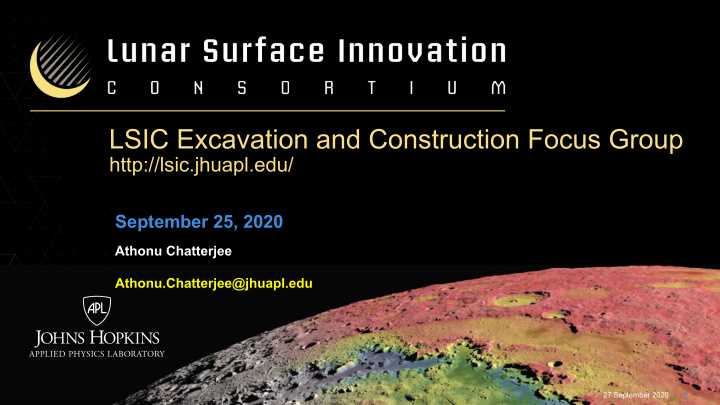



LSIC Excavation and Construction Focus Group http://lsic.jhuapl.edu/ September 25, 2020 Athonu Chatterjee Athonu.Chatterjee@jhuapl.edu 27 September 2020 1
Friendly Reminders • Slides, chat and recording will be posted in our website in 2-3 days. (http://lsic.jhuapl.edu/Focus-Areas/Excavation-and-Construction.php) • Feel free to post your questions/suggestions in ‘chat’. - We can get back to you later, if not now. • Please mute yourself if you are not speaking. 27 September 2020 2
Focus Group Update • We now have 317 members. Up almost a 100 in the last three months! • We do not have representation from big equipment makers such as Caterpillar, John Deere, etc. - Request : If you have relevant contacts in these companies please let us know. • Confluence is up and running. Please sign-up and let us start using it regularly. - http://lsic-wiki.jhuapl.edu/ (sign-up required) • Andrea Harman is the LSIC Confluence Facilitator. - Contact Andrea for access: ams573@alumni.psu.edu - Training sessions available. 27 September 2020 3
Break the Ice Lunar Challenge • Break the Ice Lunar challenge RFI notice was released on September 8. • Website: https://go.nasa.gov/32b2S4A • Submission deadline is Sep 29th 11:59 pm Eastern. 27 September 2020 4
Fall LSIC workshop (October 14-15) • Virtually hosted by ASU in collaboration with APL. • Technical focus on the interrelationships between the six LSIC focus areas in the context of surface power. • Feature keynote addresses, working sessions, and technical poster presentations. • Abstracts for posters are being accepted through Sept. 11. • http://lsic.jhuapl.edu/Events/ for more information. 27 September 2020 5
Agenda Two 20-minute presentations : (1) Prof. Shirley Dyke of Purdue University is the director of Resilient Extra-Terrestrial Habitats (RETH) institute. RETHi is a NASA-funded Space Technology Research Institute at Purdue. Shirley will talk about the research being done at her institute on resilient habitats. (2) Jason Ballard is the CEO and co-founder of ICON, an exciting company that develops advanced construction technologies by using 3D printing robotics, software and advanced materials. Jason will talk about his company and technology, and their vision for habitats for Moon and beyond. A 5-minute brief: Tim Anderson from McKean Defense will present a brief titled “MULE: CONOPS and Requirements”. Tim is working on collecting requirements for a utility lander design. 27 September 2020 6
27 September 2020 7
Excavation and Construction Focus Group Supporting STMD in developing technologies that enable affordable, autonomous manufacturing or construction for sustained human presence. The goal(s) of the LSIC Excavation and Construction focus group is to assess technologies related to lightweight manufacturing, mining, and assembly equipment that can process in-situ lunar surface materials. Relevant manufacturing and assembly processes will be assessed some of which are additive construction, deployable metal structures, sintering, molten regolith fiber pulling, etc. APL Facilitator: Athonu Chatterjee – Athonu.Chatterjee@jhuapl.edu NASA Lead: John Vickers – john.h.vickers@nasa.gov ( NASA principal technologist in the area of advanced manufacturing. Associate Director of the Materials and Processes Laboratory at NASA’s Marshall Space Flight Center. Manager of the NASA National Center for Advanced Manufacturing) Website: http://lsic.jhuapl.edu/Focus-Areas/Excavation-and-Construction.php Focus Group Composition Mailing List: LSIC_ExcavationConstruction@listserv.jhuapl.edu Academia : 37% Membership: 210 members Government : 21% Industry : 41% • Zoom Meeting: https://jhuapl.zoomgov.com/j/1605411480?pwd=a3BBR2hNSG41OUhiRyt2V3R2MXNIdz09 8
E&C Technical Areas Google Survey Results Habitat construction in lunar conditions. (Inflatable habitat, underground habitat, radiation shielding, multi- 70.5% functional materials/structures) Manufacturing processes for lunar construction. (Additive manufacturing, sintering, regolith fiber pulling) 63.6% Excavation technology for hard regolith/icy material. (Drilling, mining, lightweight construction equipment) 61.4% Autonomous vehicles and robots for E&C on lunar surface. 59.1% Lunar surface structure development. (Landing pads, berms, roads) 54.5% Increased autonomy of operations. 34.1% Virtual lunar terrain simulation. 29.5% Beyond additive technology. 22.7% Long duration robust , easily maintainable robot design for industrial scale use (not science) 2.3% Subsurface and interior imaging and composition analysis 2.3% Compressed, sifted regolith as a building material 2.3% Spacecraft refueling station development 2.3% 27 September 2020 9
Focus Group Goal • The E&C FG is tasked to define a 1 year goal. • Will collaboratively decide on a 1-year goal for us to work on as a group based on technology areas survey and NASA priorities. • Goal needs to be - Actionable - Impactful - Address clear need of NASA - Can be accomplished with existing resources - Inspired by current issues - Beneficial broadly to all stakeholders • Possible first-year goal topics: - Advanced technologies for excavation of dry and icy regolith. - Landing pad development. - ------ 27 September 2020 10
LSII System Integrator - APL A key tenet of LSII is to implement a multitude of novel collaborations across industry, academia, and government in order to successfully develop the transformative capabilities for lunar surface exploration. Origin of the APL Task • NASA was investigating using a University Affiliated Research Center (UARC) to bring efficiencies to development • LSII initiated a tasked APL, to assess system integration role for the Lunar Surface Innovation Initiative • APL established a Lunar Surface Consortium with academia and industry representatives, as well as NASA experts, that span a broad range of capabilities to execute timely studies, tasks, and/or acquisitions The Consortium will assist NASA in • Identifying lunar surface technology needs and assessing the readiness of relative systems and components • Making recommendations for a cohesive, executable strategy for development and deployment of the technologies required for successful lunar surface exploration • Providing a central resource for gathering information, analytical integration of lunar surface technology demonstration interfaces, and sharing of results
Recommend
More recommend